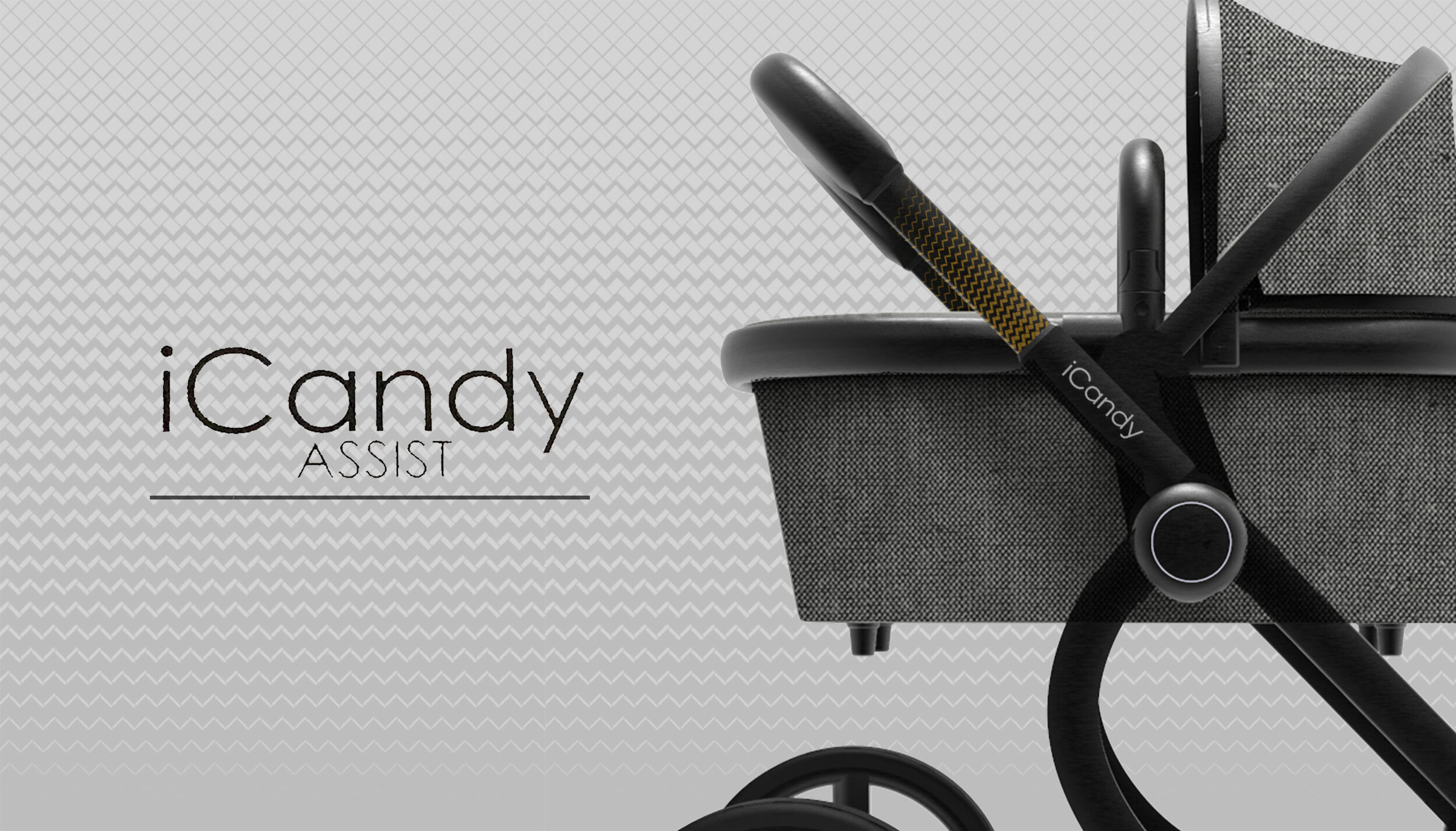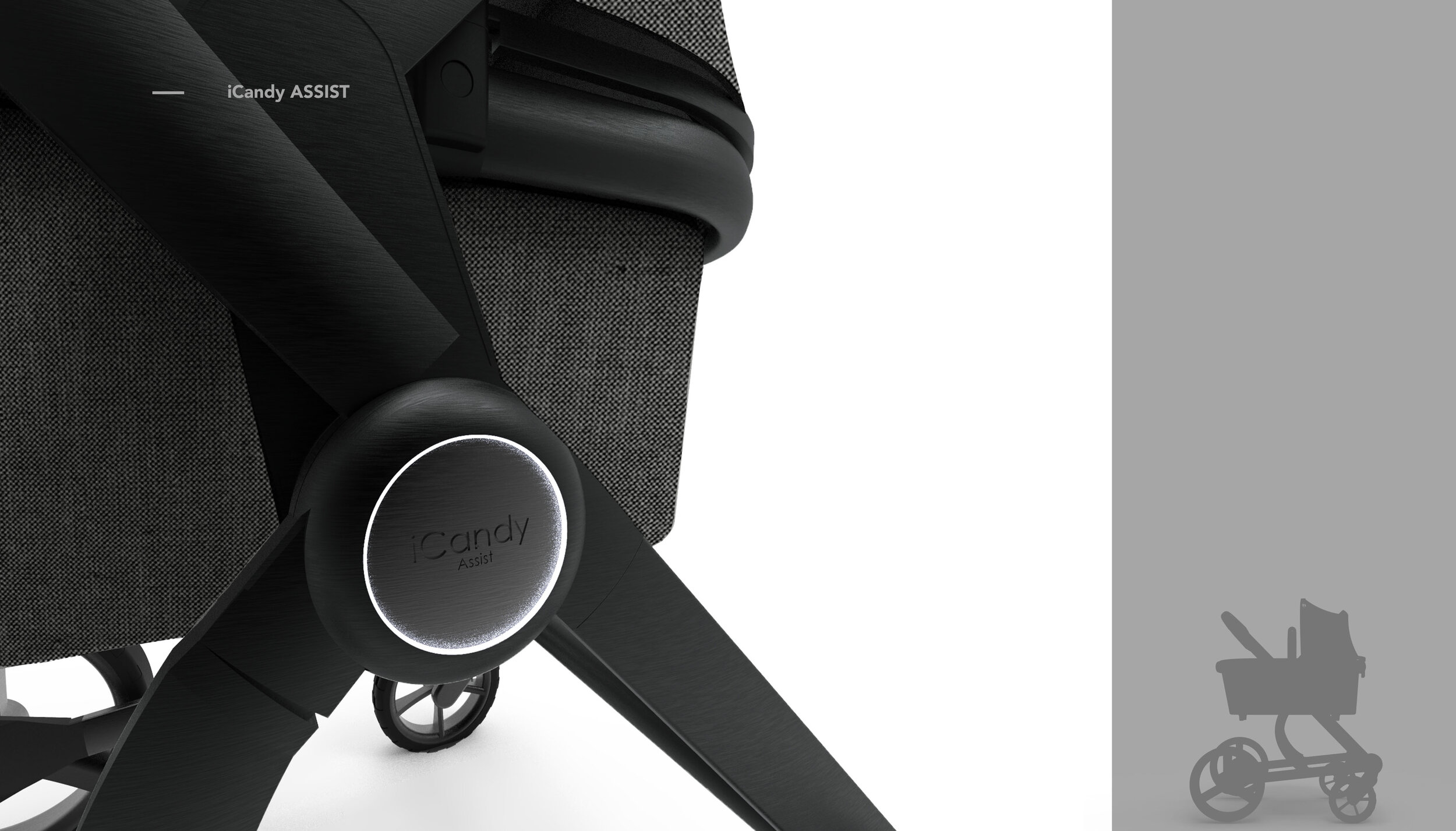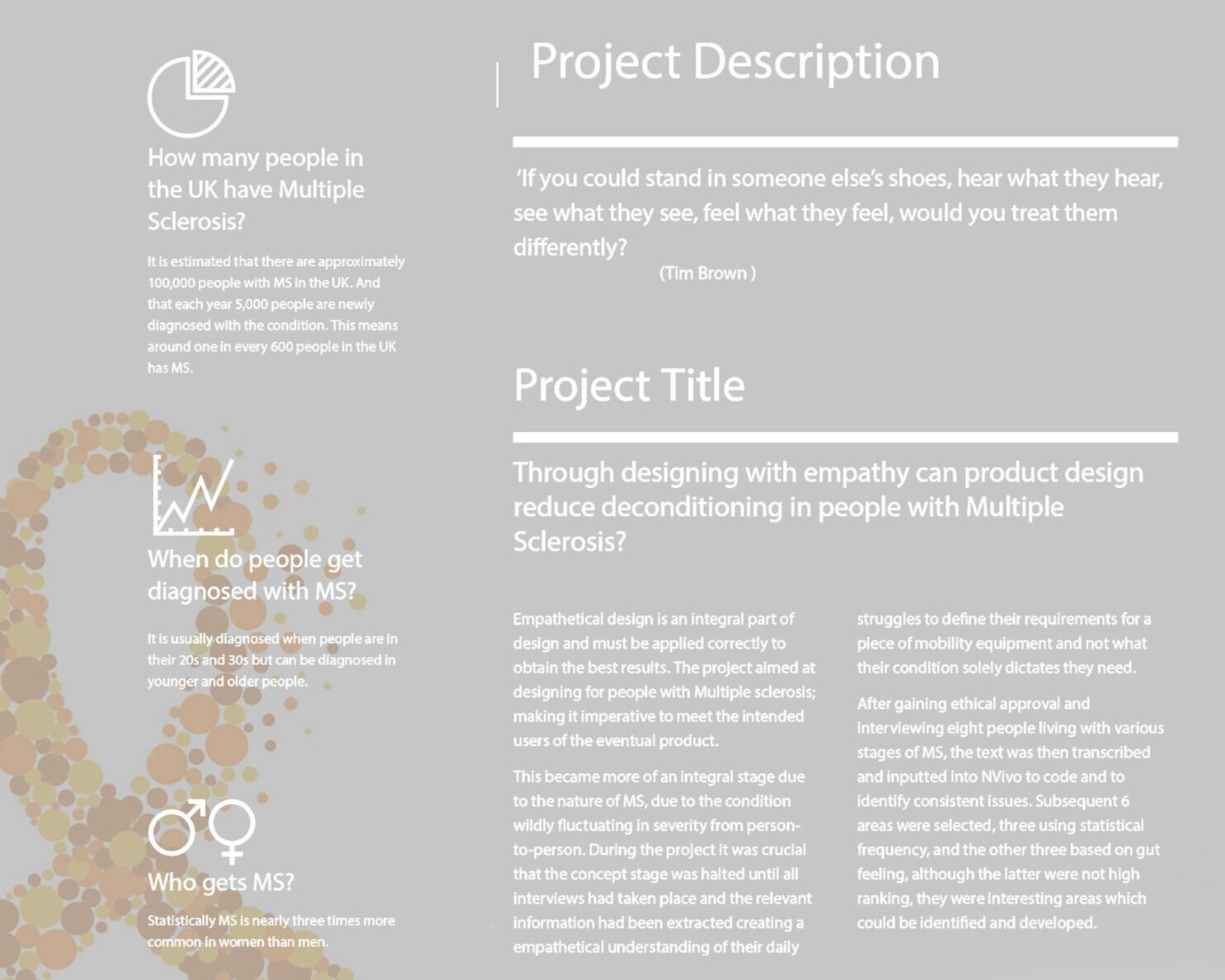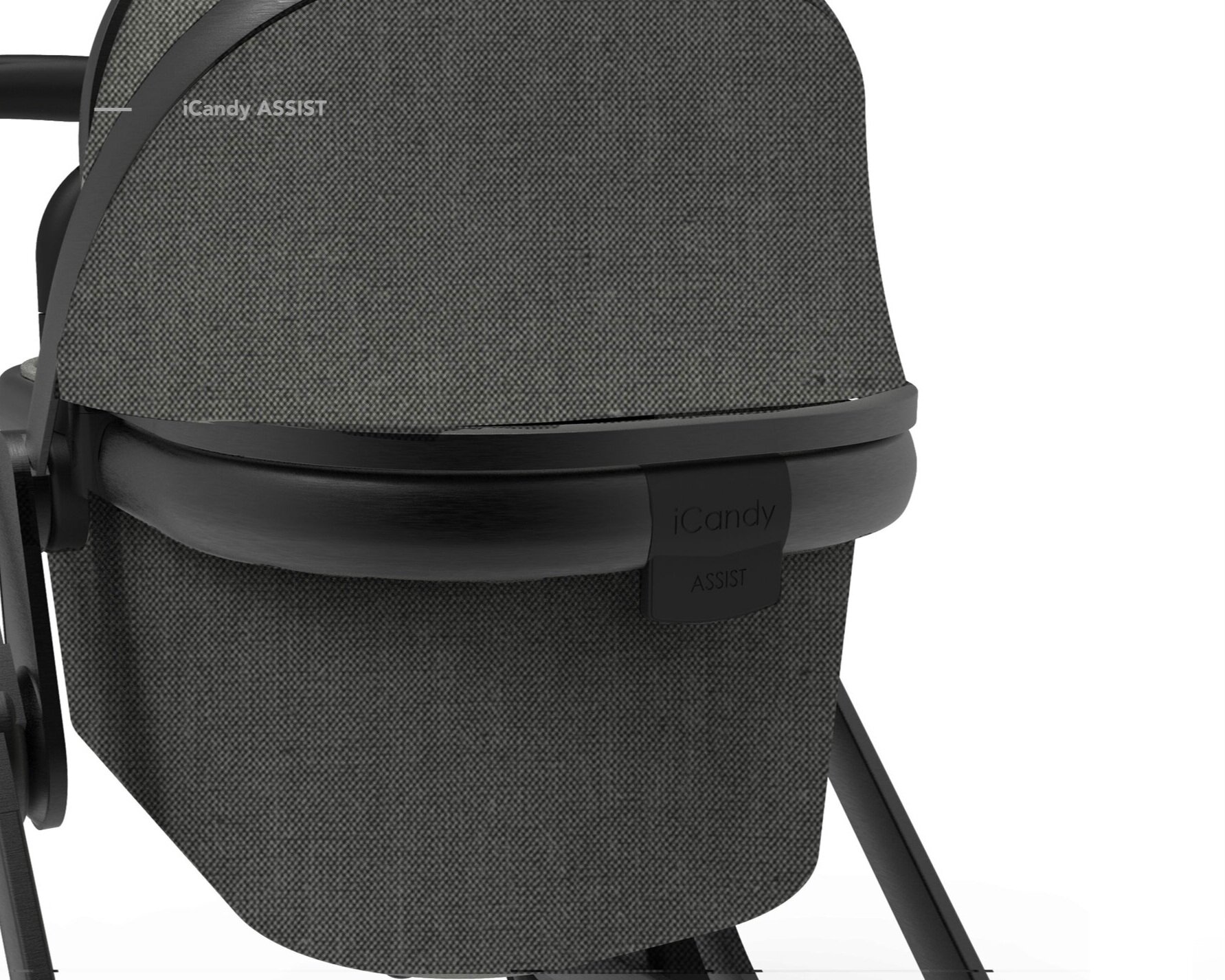
Designing mobility equipment for mothers living with Multiple Sclerosis
iCandy ASSIST
Hello and welcome to the iCandy ASSIST
This project was run during my Masters at the University of Central Lancashire. It was built on the foundation of using semi-structured face-to-face interviews with people living at various stages of Multiple Sclerosis (MS). Once my data had been collected, I used a program called nVivo to structure and code the transcribed interviews to identify common, consistent issues among the broad selection of people living with MS.
The project process is further outlined in another section of the portfolio. Please select the link below to go to that section, or scowl down to see the final design.
London Design Fair 2019
This project was submitted and accepted to be shown in the London Design Fair. For its application of qualitative and quantitative data analysis and applying the data into the design process.
Blend in
As part of the requirements set by the research meant that the product would have to blend in and not appear to be used as a mobility walker and change where the user would buy the product from.
Subtle Assist
As part of the product demands that was set by the face-to-face semi-structured interviews, the pram would help the user without showcasing that the user is receiving any. This would significantly increase the probability of the pram being bought and used by new parents living with Multiple Sclerosis.
Adaptable
Multiple Sclerosis can widely fluctuate throughout the day, calls for any assistive products that they would use to be able to do the same.

The Design process.
Context to the project
The project is structured using the three primary papers above, all based around understanding your user and two main papers highlighting the lack of research into the area and the issue of women with MS suffering relapses after giving birth.

“To understand how consumers really think and feel, it is vital to go beyond words”
— Katja Bressette

My sketching process
At this point in the process, I had created a wider variety of potential storyboards to demonstrate the potential product areas that I could develop into, though my area of interest was the pram and mobility walker hybrid.
It was essential to explore the other design that I had come up with from the research and brief identification. Below are a set of five storyboards that I explored for further development to become potential products.
Product Story Boards
This storyboard is a story of someone going through their day as someone who struggles with fatigue due to MS while looking after their newborn baby. The product in this board is an automatic response set of variable speed motors that assist the user in pushing their pram up a hill, increasing their walking distance. This concept came from the issue of a lack of disabled baby products on the market. As times have changed so has advice, leading to more people with MS having children. However, this added strain can cause relapses as well as fatigue.
Though simplistic, I like this design as it would not just benefit one demographic, but rather a plethora. This includes the elderly, children and a wide variety of disabilities that cause dexterity issues.
This watch concept was created to help prevent parents from sleeping with their children in their arms. As most people with MS suffer from varying degrees of fatigue, it is a general concern that the parent could fall asleep holding their baby. This watch will begin to vibrate if the wearer's heart rate slows and detracts that they are possible sleeping and eventually making noise until the parent wakes up and deactivates it.
This concept arose due to a nagging issue of temperamental hoists for mobility scooters. When some of the MS sufferers had to put their mobility scooters away into their cars, their hoist systems would only work if it was correctly lined up which half the time it is not. Though simple the beam of light will show the driver where to park their scooter before connecting it to its host correctly.
Depending on the age of the baby, a parent will have to change the baby a minimum of eight times. Usually, this is a task every time as the baby is kicking, with an added element of poor dexterity caused by MS this job becomes a lot more tasking. This concept was a set of Velcro or magnet stripped clothing that can easily be changed, swapped out or gain easy access to the baby without having to rely on a consistent level of hand dexterity.
A consistent theme throughout the interview process was an avoidance of equipment installed in a household, as it would make their house appear disabled. However, once they started using the equipment, they soon saw the benefit outweighed any negative aspect that was stopping them in the first place. This concept called for retractable handrails installed around the house that would only be deployed if the wearer of the watch was close by or set on a timer, reducing the mental image of the house appearing ‘disabled’.
Product area Selection
Though it is no surprise as this project is called the iCandy ASSIST, I have decided to develop the pram concept. Though it was my original gut feeling to take to forward as a concept, working through the others concepts and developing them allowed to stand back and choose an area I feel most confident in and achievable in the time-frame I had at the time
Areas of interest
When I had a tabletop review with my adviser, they suggested that I should take the easier route and select concept two, the seat buckle assist. Though I do like the concept, I felt that the idea would not represent the examining board the amount of work I undertook to get to these final concepts. However, I will come back to develop these concepts as I feel some have the ability to make a change to some peoples live outside of people living with Multiple Sclerosis.
Going forward
Going forward, I developed two more storyboards to solidify and develop the potential features of the pram and understand how someone would interact with the design.
Evolution of a product, is the necessity of design
Life span if the product
During the interview and research period of the design process, it quickly became apparent that the consensus was that they would avoid using a product if it appeared as a disabled product. This spearheaded the design aesthetics, meaning that any assistive technology that would be put into the product would have to be either disguised or hidden when not needed. Their refusal to use assistive products was caused by a sense of either looking disabled or accepting that their condition is deteriorating. However, once they began to use the assistive aid, they instantly became aware of the benefit of using it. Some that I had interviewed avoided using any equipment until absolutely necessary and eventually becoming more fatigued and worsening their condition. The Pram is designed to be used for over five years, with the eventual aim of the frame becoming the users new walking frame, as their condition progresses. This subconsciously helps them become at ease in buying an assistive product if their disability is not the leading cause of purchasing it. At the time of purpose, it is a pram for their new child, not the parents new walking frame.
Key Features
Key Features of the Product
This storyboard was created to distinguish how the user would interact with certain features of the pram. Focusing on the push assist element of the pram.
What is Push Assist?
Push assist is a hidden feature within the pram. A consistent pain point arose from the interviewees was a constant issue of fatigue, that regardless of where they travel, they have to plan rest stops and make sure that they do not exceed their walking ability. The push assist is a pair of variable-speed motors connected to the two back wheels of the pram. Which will only begin to compensate and switch on if the pram is being pushed up hill—resulting in the user to not only increasing their walking distance regardless of terrain but also not showcasing to others that they are receiving any additional support.
Selecting A Brand
When you have got over the initial excitement of having a child the next though goes to the equipment that you have to buy, a successful brand will create a product styling that is instantly recognisable and will stand out in a crowd. The market is saturated with a wide variety of brands and pram makers, each trying to stand out with their styling and features trying to catch the eye of their designed demographic. However, some stand above the rest, though this quality will come with a price. As I wanted to get the pram as close as I could to manufacturing ready in the time-frame, I had to create and keep it within existing brand identity. Taking: styling, materials used and branding to make the final design seem as realistic as possible.
I chose iCandy for a number of reasons that fit my intended user, as you can see below
Lightweight machined aluminium frame
A key issue that kept arising when speaking with the people living with MS was the issue of the product weight. You may have a great mobility walker that can give you your independence back, though if you are unable to lift it to the car boot. The product becomes redundant. With iCandys lightweight machined aluminium frame, you gain the benefit of a lightweight, strong frame that won’t rust and feel sturdy in the user’s arms.
Designed to be adaptable
iCandy design their prams to last. Their ethos is if your family grows and adapts so should your pram. This was one of the qualities that seemed to fit my demographic the most. As MS can change and alter through the day, it calls for the person living with the condition to do so as well so why shouldn’t their equipment.
The Highest of British Quality
Denoting a sense of luxury, modernity style. iCandy is a British brand through and through, designed in the UK to ensure absolute perfection and unique styling, guaranteeing the highest quality, safety and functionality for the child and the parent interacting with the product.

Form and Concept Generation
Rather than showcase all my sketch work, below is an abridge version.
To keep the pace moving and get as many designs onto the page as possible, I created quick side profile sketches. These were influenced by a wide range of existing iCandy products on the market. This was influenced by their consistent styling of handles on the pram and the connective joint centralised in the frame.
Designing for the consumer in the future
As this was to become a mobility walker later in the products life, I had to consider how the user would use the frame as a pram and as a walker, making sure that it could create a more centre of mass within the frame.
Sketch Refinement
As I began to refine my sketches, I continued the side profile sketching but started playing with the idea of the pram growing with the child and eventual mobility walker. These are two of the final selection before I started designing in 3/4 views.
Arch Concept
This ended up being the final concept. I like the curve on the back of the frame; it still kept within the iCandy aesthetic but had its only styling that could include the adaptability that the pram is going to be required.
Pivot Concept
Though I like the idea of this pram, I felt that the design would work as a pram but not as a robust and stable structure that would be required of a mobility walker. Though still had the element of adaptability, felt that the pram would have to become ever engineered.
iCandy ASSIST
After some adjustments, I felt that this design would be both fits in with the iCandys brand image and have to give stability to the person living with MS. Though there were further adjustments made to the pram, the form, on the whole, remained the same.
iCandy Push Assist
A simple line image can highlight the changes needed in your design. Once I had created the illustration, it became apparent the handle structure would have to alter to allow the user to have more hand space. Resulting in the reduction of thickness in the button section on the handle.

iCandy ASSIST
Subtle assist for new mothers living with Multiple Sclerosis
iCandy ASSIST
Designed for the disabled to be used by all
The iCandy ASSIST has been designed for people living with Multiple Sclerosis. However, like all products intended for the disabled, non-disabled people can take advantage of the product.
Designed to standout for all the right reasons
The pram is designed to catch the eye for the design and not for the assistive technology within it
Designed to be Adaptable
The iCandy ASSIST is designed to be adaptable to the users' daily fluctuation in their condition. Eventually, the frame of the pram will be used when the users' condition deteriorates and will become their mobility walker. Though this is a big step in an MS sufferers life the fact they have been using it for such a long time as a pram the transition will be much smoother psychologically.
Condition Fluctuation
When designing the iCandy ASSIST, it was imperative to create the pram as a piece of equipment that adapts to the users needs not the user bending to the limitations of a product. With the ability to move the basket forward and down the parent can have a more structured stance within the frame gaining extra stability if they find their mobility becoming laboured.
Though the iCandy ASSIST has been designed for new parents living with Multiple Sclerosis, it doesn’t mean that healthy individuals won’t benefit from the pram.
This has been a common trend amongst products designed for the disabled, only when you design for a fully non-disabled person that others begin to suffer.
Designed for Everyone
Ease of Use
As the primary user of the iCandy ASSIST are people living with Multiple Sclerosis. The pram needs to be easily used even when hand dexterity is reduced. I have overcome this with the use of large pull leavers and push buttons that do not require a constant force to be used. Though I cannot design for each person's variation of MS, I can design for the consistent issues that they can struggle with.
As you can see, the whole baby basket can be lowered and moved forward. This is so that if the parent requires more stability from the frame when pushing the child, they can do so, creating a more centralised stance similarly like a mobility walker. This may become obvious that they are using a disabled product; however, as this is to be used when required, It is a better alternative than a mobility walker.
Daily Adaptability
As part of the the hidden assist that was key element of the design, hides one of the key features within the iCandy ASSIST. Based in the back wheels and frame is a set of variable speed motors that react with the amount of pressure placed on the handles. The more pressure applied the more the wheels compensate, however this will have a delay in case of an accidental stumble by the user. This in turn helps increase the users abi’ ability to travel the same distance more consistently regardless of terrain and potentially increase their base level distance.
Variable Speed Wheels
Where is the power?
The variable-speed motors need power, though once again this needs to be hidden. I have embedded oval lithium-ion batteries in the logo section of the pram, I have put them on either side of the pram to extended the distance. However, batteries that close to a basket is not the safest, taking the product further I would look into battery ejection if they become too hot.

So What Have I Learnt?
This project has been one of the most profound in my outlook as a designer. It has taught me so much, from being able to collect data using emotion and empathy correctly, yet analyse it without passion and being able to identify a product that is backed not only by my gut feeling but statistically. This process though taking over five months including the paperwork to gain access to the participants, was worth the effort and helped obtain a much better in-depth knowledge of the condition, more than solely web-based searching could achieve. The project, on the whole, became a labour of love. Because there was such a mass amount of work it forced me to become structured and manage my time to effectively create a piece of work that I not only enjoyed but has real-world capabilities to help improve someone's life, this is what design is about. It needs to be a fine line between functionality and aesthetics, where the former needs to be prioritised.
Going Forward
Going forward I have two options that I am considering. The first would be to undertake a PhD, looking into creating a process into understanding your users and using statistical analysis to identify consistencies among interviewed transcriptions and applying them to design. However, I would still require to work in the industry for a more extended period to take my own experience and apply it to the PhD. The second is to make the design further and create a more in-depth version of this design.
To a more in-depth version of the process I undertook, please click the button to the right.
Or
Return Home




























